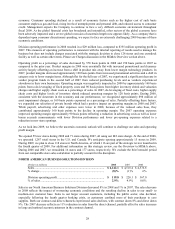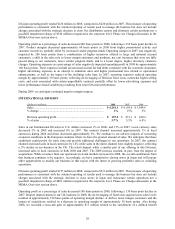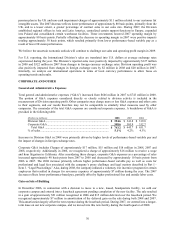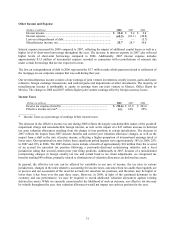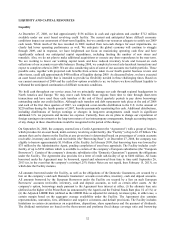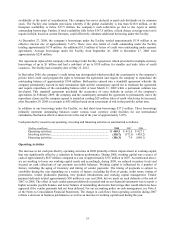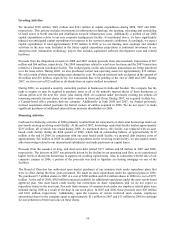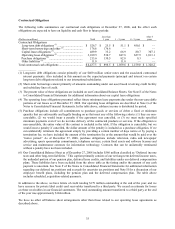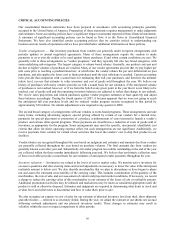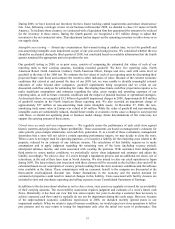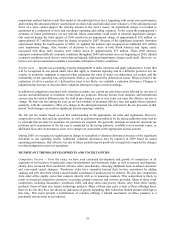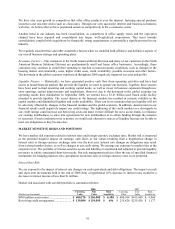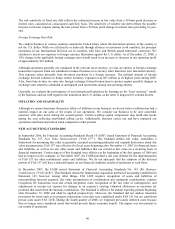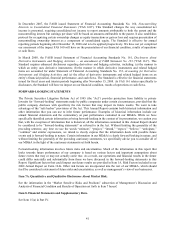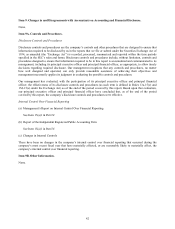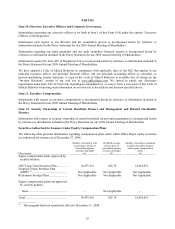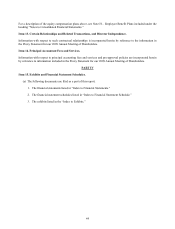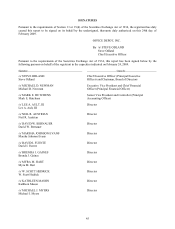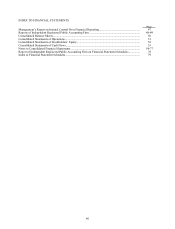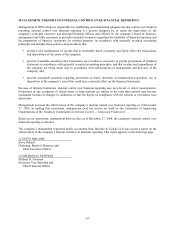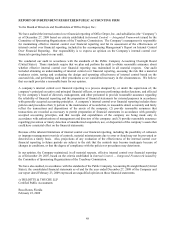Office Depot 2008 Annual Report Download - page 39
Download and view the complete annual report
Please find page 39 of the 2008 Office Depot annual report below. You can navigate through the pages in the report by either clicking on the pages listed below, or by using the keyword search tool below to find specific information within the annual report.38
impairment analysis builds a cash flow model at the individual store level, beginning with recent store performance
and trending the anticipated future results based on chain-wide and individual store initiatives. If the anticipated cash
flows of a store cannot support the carrying amount of the store’s assets, an impairment charge is recorded to
operations as a component of store and warehouse operating and selling expenses. To the extent that management’s
estimates of future performance are not realized, future assessments could result in material impairment charges.
Our analysis during the third quarter of 2008 resulted in an impairment charge of approximately $20 million, or
approximately $17 million more than the charge recorded in 2007. Because of the significant economic downturn
experienced during the fourth quarter of 2008, we updated the analysis and recognized an additional $78 million
asset impairment charge. Also, because of decisions to close stores in both North America and Japan, assets
associated with those early closures were written down by approximately $72 million. These 2008 analyses
anticipate continued difficult economic conditions throughout 2009 and modest recovery beginning in 2010. Should
economic conditions result that are worse than anticipated, additional impairment charges could result. However, we
believe our current assessment includes a reasonable estimation of future conditions.
Income taxes — Income tax accounting requires management to make estimates and apply judgments to events that
will be recognized in one period under rules that apply to financial reporting and in a different period in our tax
returns. In particular, judgment is required when estimating the value of future tax deductions, tax credits, and the
realizability of net operating loss carryforwards (NOLs), as represented by deferred tax assets. When we believe the
realization of all or a portion of a deferred tax asset is not likely, we establish a valuation allowance. Changes in
judgments that increase or decrease these valuation allowances impact current earnings.
In addition to judgments associated with valuation accounts, our current tax provision can be affected by our mix of
income and identification or resolution of uncertain tax positions. Because income from domestic and international
sources may be taxed at different rates, the shift in mix during a year or over years can cause the effective tax rate to
change. We base our rate during the year on our best estimate of an annual effective rate, and update those estimates
quarterly, with the cumulative effect of a change in the anticipated annual rate reflected in the tax provision of that
period. Such changes can result in significant interim reporting volatility.
We file our tax returns based on our best understanding of the appropriate tax rules and regulations. However,
complexities in the rules and our operations, as well as positions taken publicly by the taxing authorities may lead us
to conclude that accruals for uncertain tax positions are required. We generally maintain accruals for uncertain tax
positions until examination of the tax year is completed by the taxing authority, available review periods expire, or
additional facts and circumstances cause us to change our assessment of the appropriate accrual amount.
During 2008, we recognized a significant tax charge to reestablish a valuation allowances because of the significant
downturn in our operating results. Additional valuation allowances may be required in 2009 based on actual
operating performance. Our effective tax rate in future periods may be positively or negatively impacted by changes
in related judgments or pre-tax operations.
SIGNIFICANT TRENDS, DEVELOPMENTS AND UNCERTAINTIES
Competitive Factors — Over the years, we have seen continued development and growth of competitors in all
segments of our business. In particular, mass merchandisers and warehouse clubs, as well as grocery and drugstore
chains, have increased their assortment of home office merchandise, attracting additional back-to-school customers
and year-round casual shoppers. Warehouse clubs have expanded beyond their in-store assortment by adding
catalogs and web sites from which a much broader assortment of products may be ordered. We also face competition
from other office supply stores that compete directly with us in numerous markets. This competition is likely to
result in increased competitive pressures on pricing, product selection and services provided. Many of these retail
competitors, including discounters, warehouse clubs, and drug stores and grocery chains, carry basic office supply
products. Some of them also feature technology products. Many of them may price certain of these offerings lower
than we do, but they have not shown an indication of greatly expanding their somewhat limited product offerings at
this time. This trend towards a proliferation of retailers offering a limited assortment of office products is a
potentially serious trend in our industry.


